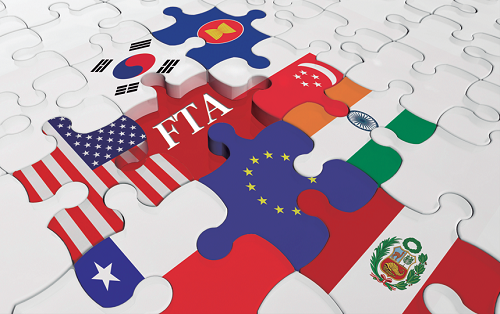FW
Comprehensive trade fair for apparel fabrics and accessories is gearing up for its biggest ever spring edition, to be held from March 16 to 18, 2016. Over 3,000 exhibitors from around the world have already confirmed to partake in Intertextile Shanghai Apparel Fabrics which will be held at the National Exhibition and Convention Center (Shanghai).
This year’s International Zone is housed in hall 7.2, while domestic exhibitors are in halls 6.1, 6.2, 7.1, 8.1 and 8.2. Domestic and international denim exhibitors are grouped together in Beyond Denim (hall 7.2), while Chinese and overseas accessories suppliers are located in hall 8.1. A relatively new addition to hall 7.2 is the France Zone, which expands in size this year after a strong debut showing at the 2015 Spring Edition. Some of France’s leading suppliers have already confirmed to take part
The France Zone is located inside SalonEurope, which is the destination to find high-end apparel fabrics and accessories producers from Europe. Some of the leading brands returning to the fair this year include Miroglio Textile from Italy, Turkey’s Soktas Tekstil and Liberty Art Fabrics from the UK. And a highlight for many buyers at the fair is the Milano Unica Pavilion from Italy, which this year features around 100 of Italy’s best textile producers showcasing their latest collections for women’s wear and men’s wear.
Organised by Japan Fashion Week Organization, the Japan Pavilion returns with over 20 exhibitors, while the Korea Pavilion – with more than 70 participants – features a large selection of man-made and functional fabrics. Organised by the Korea Fashion Textile Association (KFTA), this pavilion expands by over 50 per cent this year due to strong demand for Korean products at previous editions. One of the largest zones at the fair is the Taiwan Pavilion – organised by the Taiwan Textile Federation (TTF) – which houses over 50 exhibitors of accessories, cotton, denim, embroidery, jacquard, knit, lace, polyester, spandex and wool blended and woven fabrics suitable for mass to luxury markets. Rounding out the pavilions from Asia are the Pakistan Pavilion featuring cotton fabrics for casual wear and jeanswear and organised by the Commercial Section, Embassy of Pakistan, and the Texprocil (The Cotton Textiles Export Promotion Council) Pavilion from India.
www.messefrankfurt.com
Chinese denim mill Prosperity Textile has decided to use Better Cotton for all its lightweight cotton denim fabrics beginning with the Spring/Summer 2017 season. The Better Cotton Initiative (BCI) is a non-profit organisation that seeks to bridge the cotton supply chain from farmer to retailers by providing global standards for sustainable cotton production.
“We believe sustainable cotton is what every denim mill should use, and we value the importance Better Cotton has for both farmers and the industry in general,” said Leo Ku, president of Prosperity Textile, in a statement.
Prosperity Textile can produce up to two million yards per month of lightweight denim, including shirting and dress-weight fabrics. According to the company, there will be no change in the price with the shift to Better Cotton.
In addition to Olah, Levi Strauss & Co, G-Star Raw, Marks & Spencer, Tommy Hilfiger, Adidas, H&M, IKEA, VF, Inditex and Nike are members of BCI.
Founded in 1995, Prosperity Textile is a vertically integrated denim production facility with the capacity to produce 60 million yards annually. The company provides research and development, design, and manufacturing services to customers worldwide. Located in Shaoguan, China, the company dyes, weaves and finishes its fabrics in weights ranging from 5 oz. to 15 oz. for menswear, womenswear and children’s wear. In addition to BCI cotton, Prosperity also produces fabric from other sustainable fibres including Tencel, hemp, recycled materials and organic cotton.
www.prosperity-textile.com bettercotton.org
Vietnam's central bank is letting the country’s currency dong to fall against the dollar, hoping to close the gap between its reference rate and market forces and tap the export benefits due to a softer currency. The State Bank of Vietnam on Monday moved its reference rate for the dong from 21,890 to the dollar to 21,896, announcing that it would begin setting the rate daily by taking into account the movements of the euro, dollar, yen, yuan and other currencies. Cuts have continued nearly every day this week, mirroring a slide by China's currency.
The new policy steps away from the dong's de facto peg against the dollar. The reference rate previously has remained fixed for lengthy periods, with the central bank ensuring that the currency's value stays within a certain trading band, usually a few per cent. The shift comes after months of pressure for a weaker dong, fueled by factors including speculation around US interest rate hikes. The central bank in August widened the allowable deviation from the reference rate to 2 per cent from 1 per cent. That was followed by another expansion to 3 per cent later in the month, alongside a cut to the rate itself.
The conclusion of negotiations on the Trans-Pacific Partnership trade pact in 2015 also gave support for a weaker dong. Vietnam is expected to reap the benefits of TPP membership as its textile industry ramps up exports. A stable currency will boost the country's appeal further as it tries to position itself as a key market in Asia.
A global framework agreement (GFA) signed between IndustriALL Global Union and Swedish clothing company H&M has been an accelerator in reinstating sacked workers at garment factories in both Myanmar and Pakistan just a couple of months after it came into force.
The GFA, which was signed in November 2015, serves to protect the labour rights of 1.6 million workers in H&M’s global supply chain. In Myanmar, the GFA was key to getting trade unionists back to work, as well as achieving trade union recognition at the Jiale Fashion factory in Yangon. Eight union leaders were sacked at the garment factory in October 2015, leading to a month-long strike. The Confederation of Trade Unions in Myanmar (CTUM) reported the dispute to IndustriALL’s South East Asia regional office, which invoked the GFA with the H&M Sustainability offices in Yangon and Sweden, especially as the case raised issues on freedom of association.
H&M Sustainability then pushed for dialogue through both their local office in Yangon and Jiale Fashion’s owners in Hong Kong. H&M Sustainability, IndustriALL and CTUM were involved throughout the process until an agreement was reached between workers and the factory. As well as reinstating the dismissed workers, the factory agreed to recognize the factory trade union, the Jiale Basic Labour Organization, which is affiliated to CTUM and IndustriALL through the Industrial Workers Federation of Myanmar (IWFM).
In November 2015, 88 workers at the Denim Clothing Company (DCC) factory in Pakistan were sacked for demanding their rights. As part of the newly signed GFA with H&M, both parties worked to bring the 88 workers back to work through joint negotiations with IndustriALL Pakistani affiliate NTUF and the local management at Denim Clothing. All workers were reinstated with full pay from 26 November, the date they had been fired.
www.hm.com
Industry sources claim that China’s Ministry of Industry and Information Technology (MIIT) may soon launch a development plan for the textile industry. The plan is expected to be unveiled during the first half of this year - the 13th Five-Year Plan period (2016-2020). The measures may include focus on high-end production, textiles for automobile use, implementation of recycling system for waste textile and developing Xinjiang Uygur Autonomous Region as a major textile base by 2020 to provide easy access to the western countries.
Despite all reports and studies pointing out how falling currency, rising raw material and labour costs in China are impacting the country’s apparel market, according to the forecast made by the Euromonitor, the country will exceed the United States to become the world’s largest apparel market by 2019.
The report suggests that annual apparel sales in China will reach $333,312 million in 2019, an increase of 25 per cent from $267,246 million in 2014. While in comparison, apparel sales in the United States are estimated to reach $267,360 million in 2019, which is only 3 per cent higher than $260,050 million in 2014.
The study points out that China seems to be an even more competitive apparel market than the United States because no apparel brand was able to achieve a market share more than 1 per cent in 2014 in China, whereas in the United States, market shares of several leading apparel brands exceeded 2 per cent. Moreover, domestic brands overall outperform international brands in the Chinese apparel market.
www.euromonitor.com
The government has rejected claims made by the textile mills seeking subsidy against investments made under the Technology Upgradation Fund Scheme (TUFS) during the black-out period. Industry sources say that the subsidy claims are to the tune of Rs1,000-1,200 crores.
The blackout period is considered to be from June 28, 2010 to April 27, 2011, when the government had stopped fresh sanctions of projects under TUFS, to change it from an open-ended scheme to a closed-ended one, and launched the revised scheme only from April 2011. The allocation of a total of Rs17,822 crores approved by the Cabinet Committee on Economic Affairs (CCEA) last week for subsidy payments under both the old and the new schemes have not considered claims made for investments made during the black-out period.
The Cabinet announced a new Amended Technology Upgradation Fund Scheme (ATUFS) last week and approved Rs12,671 crores for its “committed liabilities” under the old scheme. It provided another Rs 5,151 crores for subsidy payment under the new scheme (ATUFS) over a period of seven years.
The industry is of the opinion that the government’s decision to not consider the black-out period cases as “committed liabilities” would adversely impact textile mills, which have taken loans to invest in expansion or upgradation and are simultaneously facing low demand from the importing countries.
Texmin.nic.in
Cotton USA signed Brandix Textiles as its first licensee in Sri Lanka, a developing market for US cotton exports. Brandix Textiles is one of Sri Lanka’s largest textile manufacturers and supplies high quality woven finished fabrics to leading global apparel brands.
“Brandix is a top quality fabric and apparel manufacturer with established sourcing partners in the Cotton USA supply chain, so the company is a natural fit for our licensing program,” Cotton Council International (CCI) Executive Director Bruce Atherley said, adding, “Launching a Cotton USA licensee in Sri Lanka will establish a greater presence for US cotton in South Asia and strengthen the U.S. cotton supply chain.”
Brandix Textiles’ Cotton USA license covers 400,000 square meters of 100 per cent US cotton woven fabrics. Brandix currently sources the majority of its greige fabrics from Cotton USA-licensed mills in Pakistan, ensuring the US cotton content and giving them a high quality product. Brandix officially joined the licensing program in December 2015. The company previously participated in the 2013 Cotton USA Supply Chain Marketing Conference in Dubai, which brought together 54 companies under one roof to develop new business opportunities for US cotton. Brandix met with Cotton USA fabric licensees, garment companies, and international brands and retailers at the event, making strong supply chain connections.
Brandix is also a Cotton LEADS partner. The Cotton LEADS program – initiated by Australia and the United States – offers manufacturers, brands and retailers a reliable cotton supply chain solution and confidence that their raw material is responsibly produced and identified.
Cottonusa.org www.brandix.com
After releasing the trading statement for the third quarter with disappointing merchandise sales, Marks and Spencer (M&S) CEO, Marc Bolland expressed his desire to step down from the role. After six years in the position, Bolland will retire this year. Steve Rowe, Executive Director of General Merchandise will now step into Bolland’s role. Marc Bolland will remain CEO and on the Board until the end of the current financial year on April 2, 2016 when he will hand over to Steve Rowe.
Steve Rowe has been with Marks and Spencer Group plc for over 25 years and been a Board Member since 2012. Before joining the Board, he worked in a range of senior positions across the business including director of retail and e-commerce and various positions in general merchandise.
In 2012 he was appointed by Bolland to the executive team as executive director, Food and was appointed to the Board of Marks and Spencer Group. In particularly difficult market conditions Rowe led the Food business to produce 12 consecutive quarters of like for like growth, grow its margin and all its key performance metrics, continue its record of outstanding innovation and set out a path for further profitable growth. In July 2015, he was appointed executive director, general merchandise with a mandate to improve the overall performance of that business, building on the improved design and sourcing capabilities.
www.marksandspencer.com
The United States Patent and Trademark Office recently granted Invista a US patent for bio-derived raw materials technology. The patent is for engineered polypeptides and their related crystal structure details, which are both useful for producing bio-derived compounds such as butadiene and isoprene. The company collaborated with Arzeda to develop the innovations covered by the patent, which was issued on December 29, 2015.
“The work detailed in this patent provides innovative solutions to potentially increase the global supply of bio-derived chemicals,” said Bill Greenfield, President of Invista’s Intermediates Business, adding, “This patent is an example of Invista’s biotechnology research capabilities working together with Arzeda and demonstrates our commitment to developing new bio-derived processes for a range of products.”
Alexandre Zanghellini, Co-Founder and CEO at Arzeda, said, “The issuance of this patent is yet another example of the power of combining Arzeda’s computational protein design technology Archytas with experimental screening to rapidly design synthetic enzymes. With Invista’s expertise in biotechnology and industrial scale-up, we are confident this collaboration will lead to advanced bio-processes for the production of more sustainable industrial chemicals.”
www.invista.com
"With TPP benefitting Vietnam, since it will get duty-free access to the US, Canada and Australia, Gangwar is of the opinion that his ministry along with the Ministry of Commerce is looking at signing FTAs with important markets like the EU, the US, CIS countries, South Africa and Turkey and Latin America, which can provide an edge to Indian exports."

India’s textile and garment exports target of $47.5 billion for 2015-16, with an estimated increase of almost 14 per cent against last year will not be met amid tough global economic conditions. However, textiles minister Santosh Kumar Gangwar is optimistic about India even though the Trans-Pacific Partnership (TPP) will benefit competitors like Vietnam, which will get duty-free access to the US.
Combating competition

According to Gangwar, there has been a decline in textile and apparel exports in the last few months owing to various factors. Now the ministry of textiles has initiated several steps to boost exports such as reduction of excise duty on man-made textiles from 12 per cent to 6 per cent; enhancement of market coverage under the Merchandise Exports from India Scheme (MEIS); upward revision of duty drawback rates as well as value caps; continuation of interest subvention scheme and expanding its scope; and providing working capital at 7 per cent to exporters under priority sector lending.
Of these, the government has taken action on recommendations related to MEIS. For example, duty drawback rates were raised by 2 per cent for textile products in November and interest subvention. With TPP benefitting Vietnam, since it will get duty-free access to the US, Canada and Australia, Gangwar is of the opinion that his ministry along with the Ministry of Commerce is looking at signing FTAs with important markets like the EU, the US, CIS countries, South Africa and Turkey and Latin America, which can provide an edge to Indian exports.
Wage is a wide-spread issue among most textile and apparel industries of countries exporting to the US, EU and other nations. To make India’s labour laws flexible, the textiles ministry has forwarded proposals include raising over-time limit for employees from 50 hours a quarter to 100 hours; relaxing restrictions on work during night for women in factories; revision of over-time wages at the rate of one-and-a-quarter times of the regular rate (as per ILO convention numbers 1 and 30) instead of two times; redrafting regulatory framework for labour issues in compliance with India’s ILO obligations; and also introducing fixed-term employment under the sub-section 1(15) of the Industrial Employment (Standing Orders) Act, 1946.
Positive changes in the new Textile Policy
According to Gangwar, the existing Revised Restructured TUFS (RR-TUFS) is under review and a draft note for the Cabinet Committee on Economic Affairs (CCEA) has been circulated among relevant ministries. An allocation of Rs 1,413.68 crores has been made under the TUFS scheme during 2015-16, of which Rs 882.49 crores has been disbursed until November 30, 2015. Further claims under Restructured TUFS and RR-TUFS for Rs 211.92 crores are under process with the ministry, which relates to claims up to the June quarter of 2015-16.
As far as the new Textile Policy is concerned, the textile ministry had constituted an expert committee—headed by Ajay Shankar, member secretary of the National Manufacturing Competitiveness Council—for reviewing the textile policy 2000. The committee has already submitted a draft vision, strategy and action plan, which has proposed an additional job creation of about 35 million, export of $185 billion (both textiles and apparels), domestic production level of $350 billion and investment of $200 billion by 2024-25. Based on this, the ministry has further begun talks with various stakeholders—including industry associations and export promotion councils—and started a study of textile policies of various state governments.
Texmin.nic.in












